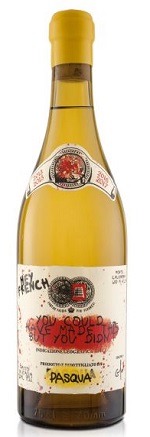The success of this dish depends on the quality of its prime ingredient, certified sustainably fished tuna. We pair this with a Veneto Bianco Hey French, You Could Have Made This But You Didn’t, Edizione II, Famiglia Pasqua.
Ingredients for 2 people:
200g MSC certified tuna, 80ml soya sauce, grated fresh ginger as desired, 1 teaspoon sugar, 1 teaspoon vinegar, sesame seeds and extra-virgin olive oil.
For the Swiss chard: 400g boiled Swiss chard, 20g raisins, 1 garlic clove and EVOO.
Directions:
Toast the sesame seeds in a pan.
Mix together the soya sauce, ginger, sugar and vinegar in a bowl and then let the tuna sit in the marinade for around 15 minutes. Coat the tuna with the toasted sesame seeds.
Reduce the marinade in a pan.
Sear the tuna on a hot skillet for at most a minute on each side, allowing the inside to remain raw.
For the Swiss chard: Sauté the garlic clove in a pan with a trickle of EVOO. Add the boiled Swiss chard and continue to sauté for a few minutes.
Add in the raisins that have been previously rehydrated. Sauté for a minute and then salt and pepper to taste.
Serve the tuna with the soya reduction on top and accompanied by the sautéed Swiss chard.

(edited by Stefania Vinciguerra)
Hey French, You Could Have Made This But You Didn’t
Bianco Veneto, Edizione II (2015-16-17-18) Famiglia Pasqua
Golden straw color and fresh scents with floral and saline notes due to the volcanic soil. The different vintages present in the blend give hints ranging from chamomile to hazelnut, citrus, tropical fruit. Complexity and structure to the palate. Good aging potential.
Production area: the Veronese side of Mount Calvarina, located in the easternmost part of the Soave appellation. This project originates from a vineyard of four and a half hectares that in the highest part reaches 600 meters above sea level, with southwest exposure, lying on top of a hill of eruptive basalt soil of volcanic origin with important limestone outcrops. From the climatic point of view, the area is favored by the altitude, which allows for very cool and windy summers, with wide temperature ranges during the ripening period.
Grape varieties: mostly Garganega with Pinot Bianco and Sauvignon. Cultivation: Guyot (4,500-5,000 vines per hectare) and pergola (3,500 vines per hectare).
Wine making: this wine is the most powerful expression of the characteristics of the blend of the best vintages of the last decade (2015, 2016, 2017 and 2018) selected as the highest expression of the vineyard throughout its history. For each selected year, vinification of white grapes takes place with maceration on the skins for about 10 hours. Afterwards, alcoholic fermentation is activated with selected yeasts at low temperatures. A partial malolactic fermentation follows with approximately 10% of the product in barriques. The process continues with ageing in second-use wood for about 6 months. The wine is then placed in steel tanks for further refinement.
Alcohol content: 13.5% vol.
Serving temperature: 10°C.
THIS RECIPE IS OFFERED BY PASQUA




